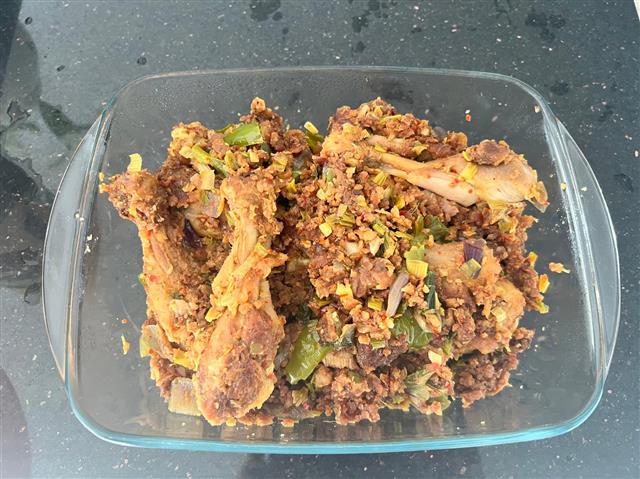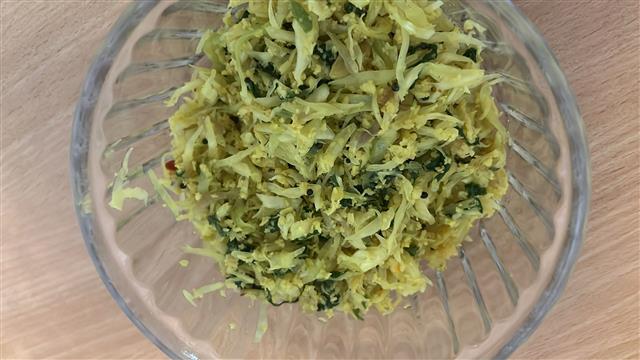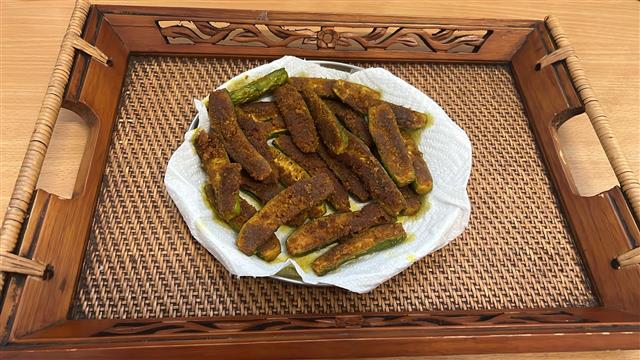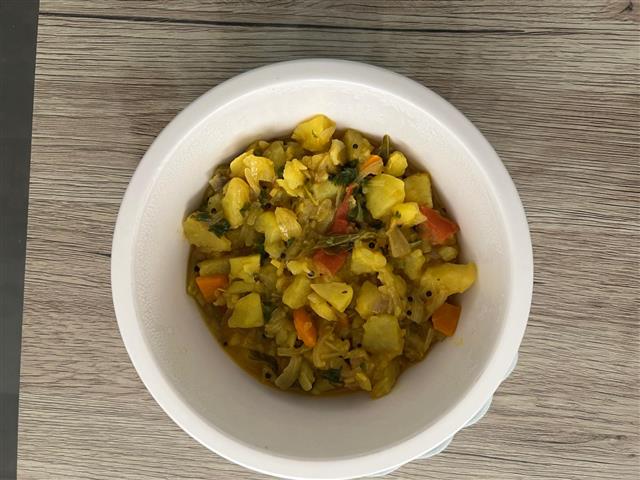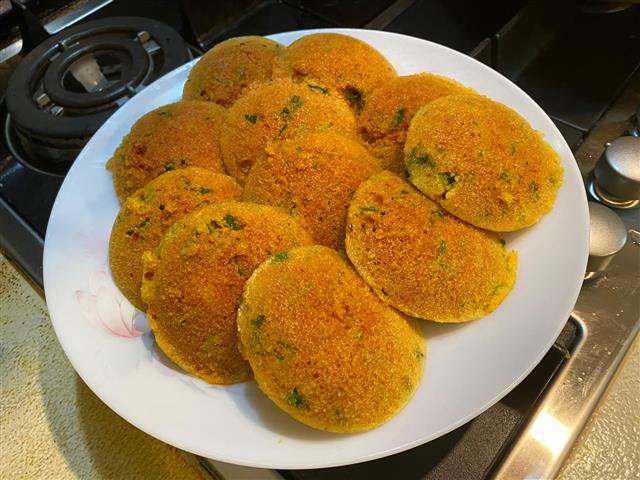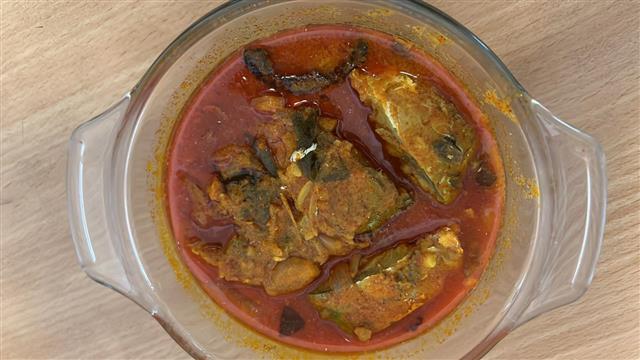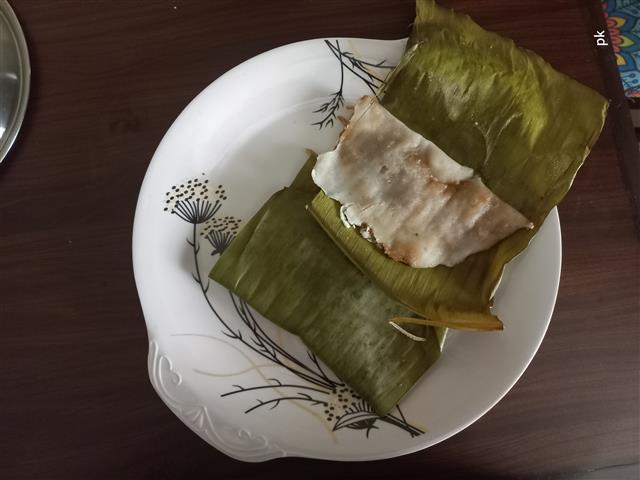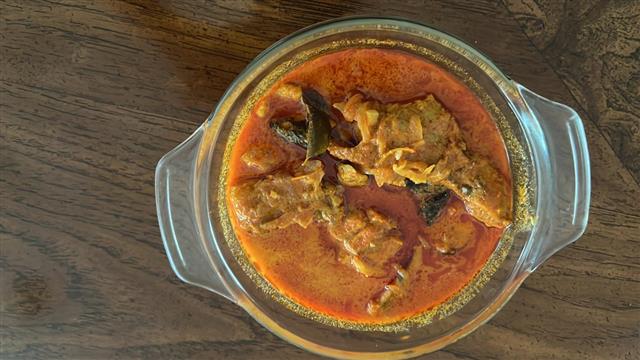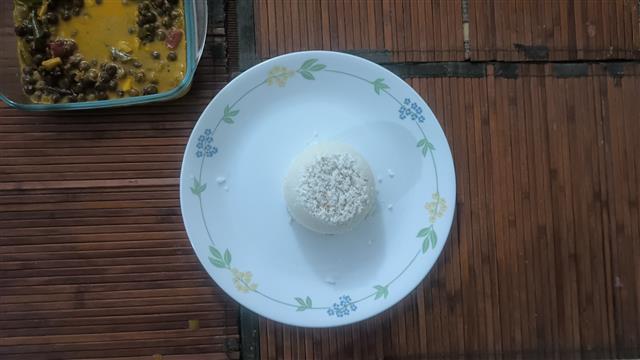
Kaya Chembu Thoran
(4 reviews)
Kaya Chembu Thoran is a traditional Kerala-style stir-fry made with raw nendran banana (kaya) and colocasia (chembu). The dish is minimally spiced and comes together rather quickly.
It's a wholesome vegetable side that pairs beautifully with rice, chapati and curries. . Soft chembu and firm kaya provide the texture contrast, while the coconut and cumin mix enhance the flavours. A tempering of mustard seeds, red chillies, and curry leaves provides the final touch of taste.
Ingredients
Directions
- Peel and chop the green raw nendran banana into small pieces.
- Peel the Chembu, rinse it and cut it into small pieces.
- In a sauté pan or frying pan, heat the coconut oil. Add the chembu and nendran banana and cook with salt and turmeric powder.
- Add water to teh vegetabels and cook for 15 minutes on medium-low heat.
- Add grated coconut, green chilli to the thoran when the vegetbels are well cooked, and mix well
- Temper mustard seeds and cumin seeds with more oil in a small frying pan. After the seeds splutter, add curry leaves. Remove from heat and add red chilli powder.
- Add the tempering to the thoran and mix well. Adjust salt as needed.
Cooking Tips
• Cut banana small: Uniform chopping helps even cooking and texture.
• Don't overcook the vegetables in water: It should be tender to touch but retain some bite. Steam or simmer just until tender.
• Use thick-bottomed pan: Prevents the dish from sticking when sautéing coconut.
• Be gentle when mixing: Chembu breaks easily. Use a light hand.
• Use fresh coconut: Frozen coconut can work, but nothing beats fresh. The flavour and texture of fresh coconut elevate the dish.
• Adjust chilli to taste: For a spicier version, add black pepper powder or use a pinch of crushed red chilli instead.
How to Serve
• Pair with hot rice or chapati
• Alongside curry, moru kachiyathu, or rasam.
• With kanji (rice gruel) for a light and wholesome meal
• With prawn or fish fry.
The Story Behind Kaya Chembu Thoran
Thoran refers to Kerala's signature coconut stir-fry technique. This dish celebrates the earthy simplicity of everyday Kerala cooking—veggies, coconut, and a tempering in coconut oil.
This thoran brings together two ingredients that are common in Kerala. Kaya and chembu often grew side-by-side near paddy fields. The sticky texture of chembu and the firmness of kaya made this thoran dish a reliable fallback meal when you need something hearty.
What is Kaya Chembu Thoran?
Kaya Chembu Thoran is a dry vegetable side dish made using authentic Kerala foods. Diced raw nendran banana and colocasia (arbi) are gently spiced and sautéed with coconut.
At home, I remember watching the chembu being peeled carefully to avoid itchiness, and the nendran banana diced to keep its shape while cooking. The final thoran was always served with rice and moru curry, a lunch classic in my home. Sometimes, i stuff this thoran into chapati and add it asa roll for my kids' lunchbox.
This dish has roots in ritual cooking too. Since it doesn't rely on garlic or overpowering spices, it often appeared during Vratham (fasting days) or Sadya spreads.
For those seeking wholesome, plant-based meals from Kerala, this dish is a recipe to bookmark.
Regional Differences
Although the base ingredients of this thoran remain consistent, subtle variations showcase the culinary diversity of this region.
Southern Kerala: A version with more chembu than kaya.
Central Kerala: Equal amounts of kaya and chembu cooked with a coconut-cumin paste and a simple red chilli tempering. This is the most widely followed version.
Northern Kerala: Uses more pepper and sometimes coconut and cumin mix is dried roasted for added depth. Other varieties of raw banana may be used.
Festive-style: For temple or Sadya cooking, the thoran is made chilli. Coconut and cumin are used with minimal oil.
Ingredient Spotlight
Nendran Banana
Rich in fibre, potassium, and resistant starch. Great for digestion and regulating blood sugar.
Small Chembu (Colocasia)
A good source of manganese, iron, and vitamin C. Though it becomes sticky when overcooked, its earthy flavour is prized in traditional dishes.
Simple to prepare, this thoran is loved not just for its flavour, but for how practical it is in the everyday Kerala cooking.
(For more Thoran recipe ideas including cherupayar and beetroot thoran, use the search box on the sidebar or scroll down the home page)
Pro Tips for Perfect Results
→ Always peel chembu under running water to reduce skin irritation.
→ Lightly oil your hands before chopping raw banana to avoid staining.
→ Don't skip the tempering as it adds fragrance and ties the dish together.
→ Use nendran variety of raw banana for authentic taste and firm texture.
→ Prepare the coconut fresh. Avoid grinding fine. Grated or dessicated texture is ideal.
Kaya Chembu Thoran Variations
- With other vegetables
Add carrots, green beans, peas or pumpkin for more flavour
- With chopped greens or legumes
Add chopped cheera (amaranth), spinach, or cherupayar.
- With Shallots or Onion
Sauté sliced shallots or onions before mixing the coconut
- Without Green Chilli:
Substitute green chilli with dried red chillies or black pepper powder for a different heat profile.
- With Coconut Paste
Instead of dry grated coconut, use a coarsely ground paste of coconut, green chilli, and cumin for a richer dish.
- With Ginger
A small piece of crushed ginger can lift the aroma.
- With Jackfruit Seeds
Boiled and diced chakka kuru can be added for a seasonal twist.
Storing & Reheating Tips
→ Storage: Store leftovers in an airtight container for up to 2 days.
→ Reheat: Gently heat on the stovetop or in the microwave for 1 minute.
→ Freeze: Not ideal after tempering, as the coconut can change texture when thawed. Freeze before adding the tempering and coconut for up to two weeks.
Common Mistakes to Avoid
→ Overcooking the cherupayar –
→ Using too much water – use enough water to cook the vegetables. Too much can make the nendram mushy
→ Not tempering the spices – The flavor depends heavily on the tempering process.
→ Skipping coconut oil – This alters the taste and you don't get the Kerala touch to the dish.
Frequently Asked Questions
- What if I don't have fresh coconut?
You can use frozen coconut (thawed) or desiccated coconut soaked in a little warm water, though fresh is best.
- Can I make this dish without coconut?
Technically yes, but it won't have the flavour or texture of a traditional thoran.
- What can I substitute for chembu?
Try yam (chena) or sweet potato. The texture will differ, but it works.
- Is it safe for kids?
Yes, but reduce the chilli and cumin. Mash lightly for younger children.
- Can I steam instead of boiling?
Yes. Steaming the chembu and kaya separately ensures better texture.
Equipment Needed
→ Thick-bottomed kadai or saute pan
→ Frying pan for tempering
→ Ladle or spatula
→ Coconut scraper
→ Chopping board and knife
